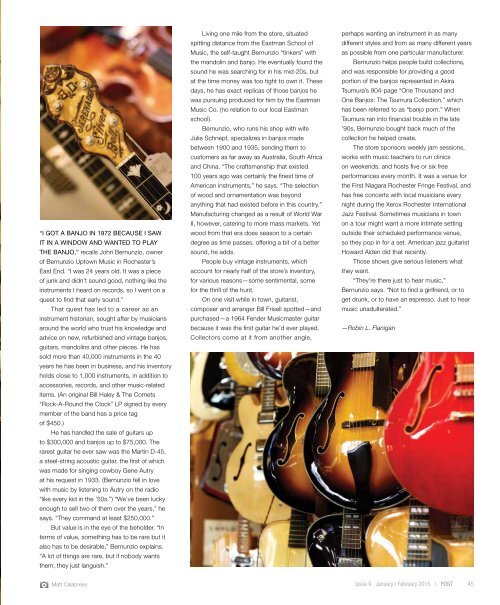You also want an ePaper? Increase the reach of your titles
YUMPU automatically turns print PDFs into web optimized ePapers that Google loves.
“I got a banjo in 1972 because I saw<br />
it in a window and wanted to play<br />
the banjo,” recalls John Bernunzio, owner<br />
of Bernunzio Uptown Music in Rochester’s<br />
East End. “I was 24 years old. It was a piece<br />
of junk and didn’t sound good, nothing like the<br />
instruments I heard on records, so I went on a<br />
quest to find that early sound.”<br />
That quest has led to a career as an<br />
instrument historian, sought after by musicians<br />
around the world who trust his knowledge and<br />
advice on new, refurbished and vintage banjos,<br />
guitars, mandolins and other pieces. He has<br />
sold more than 40,000 instruments in the 40<br />
years he has been in business, and his inventory<br />
holds close to 1,000 instruments, in addition to<br />
accessories, records, and other music-related<br />
items. (An original Bill Haley & The Comets<br />
“Rock-A-Round the Clock” LP signed by every<br />
member of the band has a price tag<br />
of $450.)<br />
He has handled the sale of guitars up<br />
to $300,000 and banjos up to $75,000. The<br />
rarest guitar he ever saw was the Martin D-45,<br />
a steel-string acoustic guitar, the first of which<br />
was made for singing cowboy Gene Autry<br />
at his request in 1933. (Bernunzio fell in love<br />
with music by listening to Autry on the radio<br />
“like every kid in the ’50s.”) “We’ve been lucky<br />
enough to sell two of them over the years,” he<br />
says. “They command at least $250,000.”<br />
But value is in the eye of the beholder. “In<br />
terms of value, something has to be rare but it<br />
also has to be desirable,” Bernunzio explains.<br />
“A lot of things are rare, but if nobody wants<br />
them, they just languish.”<br />
Living one mile from the store, situated<br />
spitting distance from the Eastman School of<br />
Music, the self-taught Bernunzio “tinkers” with<br />
the mandolin and banjo. He eventually found the<br />
sound he was searching for in his mid-20s, but<br />
at the time money was too tight to own it. These<br />
days, he has exact replicas of those banjos he<br />
was pursuing produced for him by the Eastman<br />
Music Co. (no relation to our local Eastman<br />
school).<br />
Bernunzio, who runs his shop with wife<br />
Julie Schnepf, specializes in banjos made<br />
between 1900 and 1935, sending them to<br />
customers as far away as Australia, South Africa<br />
and China. “The craftsmanship that existed<br />
100 years ago was certainly the finest time of<br />
American instruments,” he says. “The selection<br />
of wood and ornamentation was beyond<br />
anything that had existed before in this country.”<br />
Manufacturing changed as a result of World War<br />
II, however, catering to more mass markets. Yet<br />
wood from that era does season to a certain<br />
degree as time passes, offering a bit of a better<br />
sound, he adds.<br />
People buy vintage instruments, which<br />
account for nearly half of the store’s inventory,<br />
for various reasons—some sentimental, some<br />
for the thrill of the hunt.<br />
On one visit while in town, guitarist,<br />
composer and arranger Bill Frisell spotted—and<br />
purchased—a 1964 Fender Musicmaster guitar<br />
because it was the first guitar he’d ever played.<br />
Collectors come at it from another angle,<br />
perhaps wanting an instrument in as many<br />
different styles and from as many different years<br />
as possible from one particular manufacturer.<br />
Bernunzio helps people build collections,<br />
and was responsible for providing a good<br />
portion of the banjos represented in Akira<br />
Tsumura’s 904-page “One Thousand and<br />
One Banjos: The Tsumura Collection,” which<br />
has been referred to as “banjo porn.” When<br />
Tsumura ran into financial trouble in the late<br />
’90s, Bernunzio bought back much of the<br />
collection he helped create.<br />
The store sponsors weekly jam sessions,<br />
works with music teachers to run clinics<br />
on weekends, and hosts five or six free<br />
performances every month. It was a venue for<br />
the First Niagara Rochester Fringe Festival, and<br />
has free concerts with local musicians every<br />
night during the Xerox Rochester International<br />
Jazz Festival. Sometimes musicians in town<br />
on a tour might want a more intimate setting<br />
outside their scheduled performance venue,<br />
so they pop in for a set. American jazz guitarist<br />
Howard Alden did that recently.<br />
Those shows give serious listeners what<br />
they want.<br />
“They’re there just to hear music,”<br />
Bernunzio says. “Not to find a girlfriend, or to<br />
get drunk, or to have an espresso. Just to hear<br />
music unadulterated.”<br />
—Robin L. Flanigan<br />
Matt Calabrese<br />
Issue 9 <strong>January</strong> / <strong>February</strong> <strong>2015</strong> | <strong>POST</strong> 45


